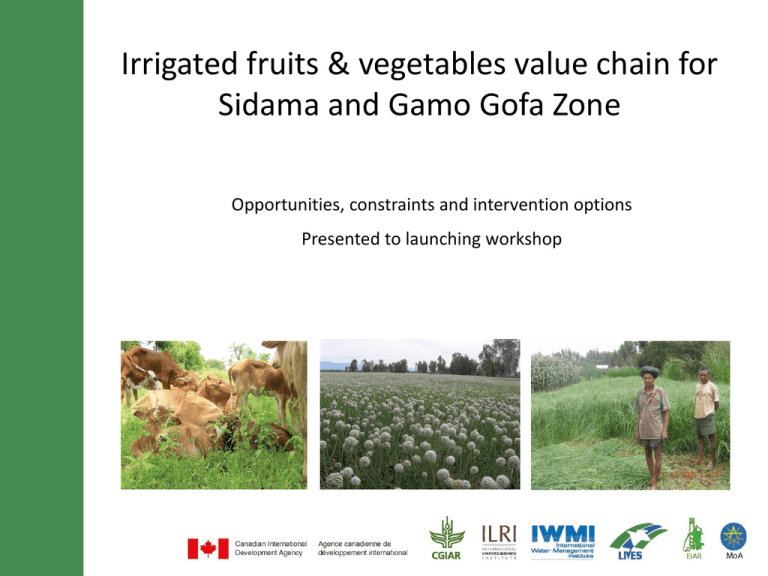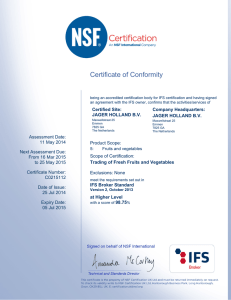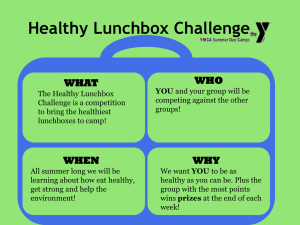SNNPR - LIVES
advertisement

Irrigated fruits & vegetables value chain for Sidama and Gamo Gofa Zone Opportunities, constraints and intervention options Presented to launching workshop Outline – Targeting processes – What are opportunities? – Irrigated fruits & Vegetables value chain constraints & intervention options • • • • • Production Irrigation practice Inputs/ services Processing and marketing Linkages – Gender interventions – Environment intervention Targeting • • • • • Zones Districts PAs Households Base line data – To set up bench mark Commodities approved for two zones Zones Districts Selected commodities Dairy Beef Sidama G.Gofa Small Rumi. Poultry Honey Irrig. Fruits & veget. Arbegona x X X X Bansa x X X X Bona Zuria x X X X Bonke X X X x A/minch zuria X X X x Mirab Abaya X X x x Opportunities • Market/internal, external • Massive push from government side – Organizational – Institutional – Capacity building – Access to credit/OMF, SMF • Increased awareness of farmers • Increased awareness of private sectors Commodities value chain and intervention areas 1. Fruits and vegetables production status – Major fruits:- Banana, mango, avocado, apple ,papaya – Major vegetables:-Tomato, pepper, onion, garlic, cabbage, potato – Intensively produced as cash crop and/or for hh consumption Major limitations – Knowledge /skill in market focused improved agronomic practices – Productivity/unit area – Marketable varieties and other planting materials – Diseases and pests Intervention options – Capacity building – Introduction of improved seeds and planting materials from within and abroad – Integrated/organic disease and pest control Irrigation practices – Schemes in zones: Sidama 13, Gamo Gofa 40 – In target districts: Sidama 3, Gamo Gofa 9 – Numerous artificial dams, hand dug wells, etc • Water lifting mechanisms in practice – Motorized pumps (2hp-4hp), Rope and washer, Tridle, manual using bucket • Limitations – Skill and knowledge – Underutilization of schemes/pumps – Malfunctioning of schemes – irrigation scheme management Irrigation cont…. • Intervention options – Capacity building – Assessing current utilization status – Strengthening and/or initiating water users association – Training WUA leaders in leadership skill Inputs and services supply system • Inputs – Seeds, seedlings, agrochemicals, pumps, sprayers – Supplied by both public and private traders – Intensively used by farmers • Limitations – Timely availability and sustainability of supply – Quality – Trustworthiness – Maintenance and services Intervention options • Engaging farmer in input supply service/ for seeds, seedlings • Strengthening private suppliers/ for pumps, sprayers, agrochemicals • Strengthening public regulatory unit with manpower and facilities • Strengthening private sector/youth groups in maintenance and service of Processing and marketing • Constraints – – – – Focused on local market Storing and transporting Value addition Bargaining power • Intervention options – – – – Promote collective marketing Developing certifying capacity Promoting zone specific brand marketing better transporting and storing facilities to reduce losses – Review some NGOs processing experience (ECOPIA, etc) and scaling out if it sounds feasible Linkages Constraints • Less linkage among producers, input suppliers, service providers and traders at different locations Intervention options • Facilitate formation of platform for dominant actors • Initiating linkage between farmers and marketing groups such as wholesealers and retailers at ifferent level • Initiate linkage with private and public sectors seedling producers with private/public service providers for provision of planting materials, inspection and certification , technical support Gender intervention • Prioritizing women for services ( capacity building, access to credit, etc) • Introducing HH work loading reducing technologies • Engaging women business ( seedling production, agrochemicals trading, small scale processing, etc) Environment • Reviewing impact of each intervention on environment (positive/negative) – Awareness on negative impact of agrochemicals/proper handling – Salinity due to excessive irrigation – Depletion of underground water if any – Awareness creation on malaria and other vector disease spread





